HP Deskjet 6988dt User Manual

HP Deskjet 6980 series
User's guide
Hewlett-Packard Company notices
The information contained in this document is subject to change without notice.
All rights reserved. Reproduction, adaptation, or translation of this material is prohibited without prior written permission of Hewlett-Packard, except as allowed under copyright laws.
The only warranties for HP products and services are set forth in the express warranty statements accompanying such products and services. Nothing herein should be construed as constituting an additional warranty. HP shall not be liable for technical or editorial errors or omissions contained herein.
Acknowledgements
Microsoft, Windows, and Windows XP are registered trademarks of Microsoft Corporation.
TrueType is a U.S. trademark of Apple Computer, Inc.
Adobe, Adobe Photoshop, and Acrobat are trademarks of Adobe Systems Incorporated.
Bluetooth is a trademark owned by its proprietor and used by HewlettPackard Company under license.
Copyright 2005 Hewlett-Packard Development Company, L.P.
Accessibility
The HP printer provides a number of features that make it accessible for people with disabilities.
Visual
The printer software is accessible for users with visual impairments or low vision through the use of Windows accessibility options and features. It also supports most assistive technology such as screen readers, Braille readers, and voice-to-text applications. For users who are color blind, colored buttons and tabs used in the software and on the HP printer have simple text or icon labels that convey the appropriate action.
Mobility
For users with mobility impairments, the printer software functions can be executed through keyboard commands. The software also supports Windows accessibility options such as
StickyKeys, ToggleKeys, FilterKeys, and MouseKeys. The printer doors, buttons, paper trays, and paper guides can be operated by users with limited strength and reach.
Support
For more details about the accessibility of this product and HP's commitment to product accessibility, visit HP's Web site at: www.hp.com/accessibility.
Contents
1 |
Welcome................................................................................................................. |
4 |
2 |
Special features..................................................................................................... |
5 |
3 |
Get started.............................................................................................................. |
6 |
|
Printer features ....................................................................................................... |
6 |
|
Buttons and lights ................................................................................................... |
8 |
|
Paper trays ........................................................................................................... |
10 |
|
Photo/envelope feeder ......................................................................................... |
12 |
|
Print cartridges ..................................................................................................... |
15 |
|
Ink-backup mode .................................................................................................. |
16 |
|
Automatic paper-type sensor ............................................................................... |
17 |
4 Connect to the printer......................................................................................... |
18 |
|
|
USB ...................................................................................................................... |
18 |
|
Wireless networking ............................................................................................. |
19 |
|
Wired Ethernet networking ................................................................................... |
47 |
|
Bluetooth wireless printing ................................................................................... |
53 |
|
HP iPAQ Wi-Fi printing ......................................................................................... |
57 |
5 |
Print photos......................................................................................................... |
59 |
|
Print borderless photos ........................................................................................ |
59 |
|
Print photos with a border .................................................................................... |
61 |
|
HP Real Life technologies .................................................................................... |
62 |
|
Photo print cartridge ............................................................................................. |
63 |
|
Maximum dpi ........................................................................................................ |
64 |
|
Advanced color settings ....................................................................................... |
65 |
|
Color management ............................................................................................... |
66 |
|
Gray photo print cartridge ..................................................................................... |
66 |
|
Exif Print ............................................................................................................... |
67 |
|
Store and handle photo paper .............................................................................. |
67 |
|
Save money when printing photos ....................................................................... |
68 |
6 Print photos from a digital camera.................................................................... |
69 |
|
|
Use a PictBridge camera ...................................................................................... |
69 |
|
Use a Bluetooth camera phone ............................................................................ |
71 |
7 |
Print other documents........................................................................................ |
72 |
|
E-mail ................................................................................................................... |
72 |
|
Letters ................................................................................................................... |
73 |
|
Documents ........................................................................................................... |
74 |
|
Envelopes ............................................................................................................. |
75 |
|
Brochures ............................................................................................................. |
76 |
|
Greeting cards ...................................................................................................... |
77 |
|
Postcards .............................................................................................................. |
78 |
|
Transparencies ..................................................................................................... |
79 |
|
Labels ................................................................................................................... |
80 |
|
Index cards and other small media ...................................................................... |
82 |
|
Booklets ................................................................................................................ |
83 |
|
Posters ................................................................................................................. |
84 |
|
Iron-on transfers ................................................................................................... |
85 |
User's guide |
1 |
|
Banners ................................................................................................................ |
86 |
|
CD/DVD tattoos .................................................................................................... |
87 |
8 |
Printing tips.......................................................................................................... |
90 |
|
Printing shortcuts .................................................................................................. |
90 |
|
Fast/economical printing ....................................................................................... |
91 |
|
General everyday printing .................................................................................... |
91 |
|
Presentation printing ............................................................................................ |
91 |
|
Print in grayscale .................................................................................................. |
91 |
|
Select a print quality ............................................................................................. |
92 |
|
Set the page order ................................................................................................ |
92 |
|
Print multiple pages on a single sheet of paper ................................................... |
93 |
|
Print a different first page ..................................................................................... |
93 |
|
Print preview ......................................................................................................... |
95 |
|
Set a custom paper size ....................................................................................... |
95 |
|
Select a paper type .............................................................................................. |
96 |
|
Select a paper source .......................................................................................... |
96 |
|
Print task quick sets .............................................................................................. |
97 |
|
Automatic two-sided printing ................................................................................ |
99 |
|
Manual two-sided printing .................................................................................. |
101 |
|
Resize a document ............................................................................................. |
105 |
|
Watermarks ........................................................................................................ |
107 |
9 |
Printer software................................................................................................. |
109 |
|
Printer Properties dialog box .............................................................................. |
109 |
|
What's This? help ............................................................................................... |
109 |
|
Ink Status window ............................................................................................... |
109 |
|
Download printer software updates .................................................................... |
110 |
10 |
Maintenance....................................................................................................... |
112 |
|
Install print cartridges ......................................................................................... |
112 |
|
Set the auto-off feature ....................................................................................... |
115 |
|
Align the print cartridges ..................................................................................... |
115 |
|
Calibrate color .................................................................................................... |
116 |
|
Automatically clean print cartridges .................................................................... |
116 |
|
Print a test page ................................................................................................. |
116 |
|
View estimated ink levels ................................................................................... |
116 |
|
Maintain the printer body .................................................................................... |
117 |
|
Remove ink from your skin and clothing ............................................................ |
117 |
|
Manually clean print cartridges ........................................................................... |
117 |
|
Maintain print cartridges ..................................................................................... |
118 |
|
Printer Toolbox ................................................................................................... |
119 |
11 |
Troubleshooting................................................................................................ |
121 |
|
Ethernet problems .............................................................................................. |
121 |
|
Wireless communication problems ..................................................................... |
123 |
|
Printer does not print .......................................................................................... |
127 |
|
Paper jam ........................................................................................................... |
128 |
|
Paper problems .................................................................................................. |
129 |
|
Paper mismatch .................................................................................................. |
130 |
|
Printer is stalled .................................................................................................. |
131 |
|
Print cartridge problems ..................................................................................... |
131 |
|
Photos do not print correctly ............................................................................... |
133 |
|
PictBridge problems ........................................................................................... |
136 |
2 |
HP Deskjet 6980 series |
Contents
|
Bluetooth printing problems ................................................................................ |
137 |
|
Banners do not print correctly ............................................................................ |
138 |
|
Print quality is poor ............................................................................................. |
139 |
|
Document is misprinted ...................................................................................... |
140 |
|
Problems with borderless documents ................................................................ |
141 |
|
Error messages .................................................................................................. |
145 |
|
Printer lights are on or flashing ........................................................................... |
147 |
|
Document prints slowly ....................................................................................... |
149 |
|
If you continue to have problems ....................................................................... |
150 |
|
HP support process ............................................................................................ |
150 |
12 |
Accessories....................................................................................................... |
151 |
|
Automatic Two-Sided Printing Accessory (duplexer) ......................................... |
151 |
|
250-Sheet Plain Paper Tray ............................................................................... |
159 |
|
Auto Two-Sided Print Accessory with Small Paper Tray .................................... |
166 |
13 |
Supplies.............................................................................................................. |
176 |
|
Paper .................................................................................................................. |
176 |
|
USB cables ......................................................................................................... |
176 |
|
Accessories ........................................................................................................ |
176 |
14 |
Specifications ................................................................................................... |
177 |
|
Printer specifications .......................................................................................... |
177 |
15 |
Environmental information............................................................................... |
178 |
|
Environmental statement .................................................................................... |
178 |
|
Print cartridge recovery ...................................................................................... |
179 |
User's guide |
3 |
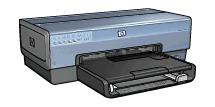
1 Welcome
To find an answer to a question, select one of the following topics:
●Special features
●Get started
●Connect to the printer
●Print photos
●Print photos from a digital camera
●Print other documents
●Printing tips
●Printer software
●Maintenance
●Troubleshooting
●Optional accessories
●Supplies
●Specifications
●Environmental information
4 |
HP Deskjet 6980 series |
2 Special features
Congratulations! You have purchased an HP Deskjet printer that is equipped with several exciting features:
●Built-in networking capabilities: Connect to either a wired or a wireless network without using an external print server.
●Ink-backup mode: Use ink-backup mode to continue printing with one print cartridge when the other print cartridge has run out of ink.
●Print Cancel button: Cancel print jobs at the touch of a button.
●Borderless printing: Use the entire page surface when printing photos and brochures with the borderless printing feature.
●Real Life technologies: Get better photos easier with HP Real Life technologies. Automatic red-eye removal and adaptive lighting to enhance detail in shadows are just a few of the many technologies included.
●Six-ink upgradeable printing: Enhanced photo printing with a six-inkphoto print cartridge (purchased separately).
HP Vivera Inks deliver true-to-life photo quality and exceptional fade resistance resulting in vivid colors that last. HP Vivera Inks are specially-formulated and scientifically tested for quality, purity and fade resistance.
●Printing from a digital camera: Print photos directly from a PictBridge-compatible camera using the front USB port.
●Automatic paper-type sensor: Use the auto paper-type sensor to optimize print quality for various papers.
●Quiet Mode: Use the Quiet Mode button when you require quieter printing such as with a baby sleeping or a client in the office.
●Photo/envelope feeder: Use the photo/envelope feeder to conveniently print single envelopes, photos, or postcards.
●Bluetooth printing: Print images without a cable using Bluetooth. Use an optional HP Bluetooth Wireless Printer Adapter to print images from most Bluetooth devices to the printer without a cable connection.
●Optional Automatic Two-Sided Printing Accessory: Purchase an Automatic Two-Sided Printing Accessory to print two-sided documents automatically.
●Optional Auto Two-Sided Print Accessory with Small Paper Tray: Purchase an Auto Two-Sided Print Accessory with Small Paper Tray to print two-sided documents automatically and load small media from the back of the printer.
●Optional 250-Sheet Plain Paper Tray Accessory: Purchase a 250-Sheet Plain Paper Tray Accessory to expand the printer's paper-handling capability.
User's guide |
5 |

3 Get started
●Printer features
●Buttons and lights
●Paper trays
●Photo/envelope feeder
●Print cartridges
●Ink-backup mode
●Automatic paper-type sensor
For a description of the optional accessories, see the optional accessories page.
Printer features
The printer has several features to make printing easier and more efficient.
1 |
Buttons and lights |
2 |
Paper trays |
3 |
Photo/envelope feeder |
4 |
Front USB port |
6 |
HP Deskjet 6980 series |
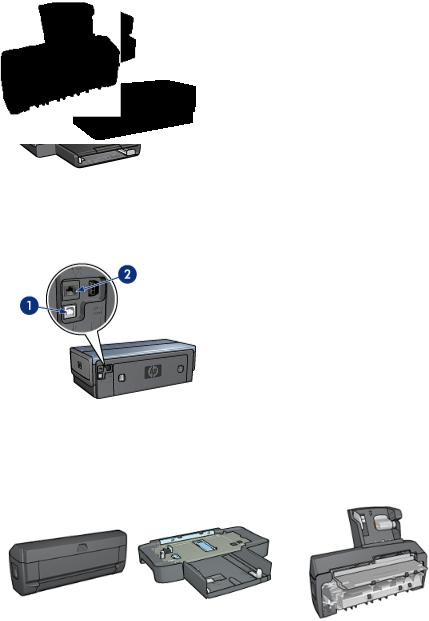
1 |
Print cartridges |
2 |
Automatic paper-type sensor (not illustrated) |
3 |
Ink-backup mode (not illustrated) |
1 |
Rear USB port |
2 |
Wired Ethernet port |
Optional accessories
Automatic Two-Sided |
250-Sheet Plain Paper |
Auto Two-Sided Print Accessory |
Printing Accessory |
Tray (optional) |
with Small Paper Tray (optional) |
(optional) |
|
|
User's guide |
7 |
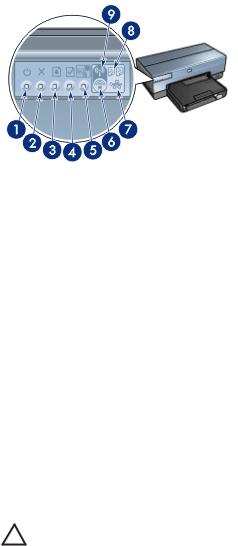
Chapter 3
Buttons and lights
Use the printer buttons to turn the printer on and off, cancel a print job, restart a job, operate in Quiet Mode, and set up a wireless connection with SecureEasySetup. The printer lights give you visual cues about the status of the printer.
1 |
Power button and light |
2 |
Print Cancel button |
3 |
Resume button and light |
4 |
Report Page button |
5 |
Quiet mode button |
6 |
SecureEasySetup button |
7 |
Network light |
8 |
Print Cartridge Status lights |
9 |
Wireless Status light |
For a description of the following buttons and lights, click the appropriate option:
●Report Page button
●SecureEasySetup button
●Network light
●Wireless Status light
Power button and light
Use the Power button to turn the printer on and off. It can take a few seconds for the printer to turn on after you press the Power button.
The Power light flashes when the printer is processing.
Caution Always use the Power button to turn the printer on and off. Using a power strip, surge protector, or a wall-mounted switch to turn the printer on and off might cause printer failure.
The printer is designed with an auto-off feature that, when set, automatically places the printer into a low power mode when it has been idle for 30 minutes. In this mode, the printer continues to consume a maximum 3.0 watts of power with the radio off (maximum 5.5 watts with the radio on) and turns back on automatically when print jobs are sent to the printer. You can manually turn the printer off by pressing and holding the Power button
8 |
HP Deskjet 6980 series |
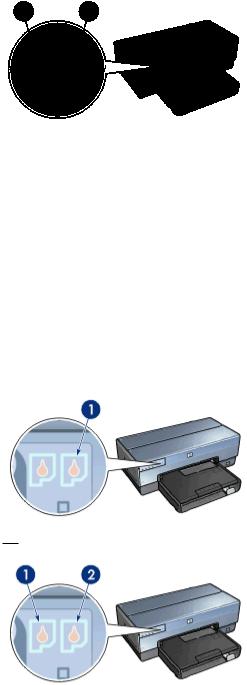
for three seconds. When the printer is manually turned off, the printer uses less than one watt of power.
Note Energy consumption can be prevented by turning the printer power off, and then disconnecting the end of the printer power cord from the electrical source.
Print Cancel button
Pressing the Print Cancel button cancels the current print job.
Resume button
The Resume light flashes when an action is required, such as loading paper or clearing a paper jam. When the problem is solved, press the Resume button to continue printing.
Quiet mode button
Use the Quiet Mode feature when you have an occasion that requires quieter printing such as a baby sleeping or a client in the office. By pressing the Quiet Mode button, the speed and sound level of the print job is reduced. To resume normal printing speed, press the Quiet Mode button again. The button is illuminated when Quiet Mode is active.
Quiet mode can be used in Normal, Fast Normal, and Draft print modes.
If the printer is printing while the Quiet Mode button is pressed, Quiet Mode goes into effect on the next page. The light on the Quiet Mode button will blink to show that the mode is pending, and then turn on fully when Quiet Mode is in effect.
Print Cartridge Status lights
The Print Cartridge Status lights indicate the status of the print cartridges.
1 Print Cartridge Status lights
User's guide |
9 |
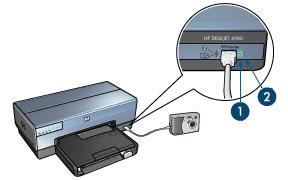
Chapter 3
1.The left status light represents the tri-color print cartridge, which is installed in the left side of the print cartridge cradle.
–The light is on and solid when the tri-color print cartridge is low on ink.
–The light flashes when the tri-color print cartridge needs to be serviced.
2.The right status light represents the print cartridge that is installed in the compartment on the right side of the print cartridge cradle. That print cartridge can be the black print cartridge, the photo print cartridge, or the gray photo print cartridge.
–The light is on and solid when the black, photo, or gray photo print cartridge is low on ink.
–The light flashes when the black, photo, or gray photo print cartridge needs to be serviced.
PictBridge lights
Plug a PictBridge-enabled camera into the front USB port using a digital camera USB cable to print digital photographs.
1 |
Connection light |
2 |
Error light |
When a PictBridge-compatible camera is connected correctly, the green Connection light is illuminated. The printer Power light flashes and the Connection light remains lit solid when printing from the camera. If the camera is not PictBridge-compatible or is not in PictBridge mode, the amber Error light flashes.
Paper trays
The printer has two paper trays:
In tray
The In tray holds paper or other media.
10 |
HP Deskjet 6980 series |

1 In tray
Slide the paper guides firmly against the edges of the media on which you are printing.
1 |
Paper-width guide |
2 |
Paper-length guide |
Out tray
Printed pages are deposited in the Out tray.
1 |
Out tray |
2 |
Photo/envelope feeder |
Use the photo/envelope feeder to print single envelopes, small photos, and cards. Raise the Out tray to load paper or other media. Lower the Out tray before printing.
User's guide |
11 |

Chapter 3
To prevent paper from falling out of the Out tray, fully pull out the Out-tray extension. If you are printing in the Fast draft mode, unfold the Out-tray extension stop.
Do not unfold the Out-tray extension stop when printing on legal paper.
1 |
Out-tray extension |
2 |
Out-tray extension stop |
After the print job is complete, fold the Out-tray extension stop, and then push the Outtray extension into the Out tray.
Photo/envelope feeder
Use the photo/envelope feeder to print a variety of media sizes including the following documents:
●Envelopes
●Photos
●Postcards
12 |
HP Deskjet 6980 series |
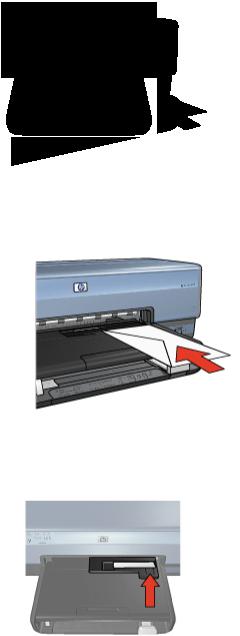
1 Photo/envelope feeder
Envelopes
Follow these steps to use the photo/envelope feeder for single envelopes:
1.Insert the envelope into the photo/envelope feeder with the side to be printed on facing down and the flap to the left.
2.Push the envelope into the printer as far as it will go without bending.
3.Slide the photo/envelope feeder forward as far as it will go.
4.Print the envelope.
User's guide |
13 |

Chapter 3
Photos
Follow these steps to use the photo/envelope feeder to print a single photo:
1.Insert the photo paper into the photo/envelope feeder with the side to be printed on facing down.
2.Gently push the photo paper into the photo/envelope feeder as far as it will comfortably go.
3.Slide the photo/envelope feeder forward as far as it will go.
4.Print the photo.
Postcards
Follow these steps to use the photo/envelope feeder to print a single postcard:
1.Insert the postcard into the photo/envelope feeder with the side to be printed on facing down.
2.Gently push the postcard into the photo/envelope feeder as far as it will comfortably go.
14 |
HP Deskjet 6980 series |

3.Slide the photo/envelope feeder forward as far as it will go.
4.Print the postcard.
Print cartridges
Four print cartridges can be used with the printer.
1 |
Black print cartridge |
2 |
Tri-color print cartridge |
3 |
Photo print cartridge |
4 |
Gray photo print cartridge |
Note The availability of print cartridges varies by country/region.
Use print cartridges
The print cartridges can be used in the following ways:
●Everyday printing: Use the black and tri-color print cartridges for everyday print jobs.
●Quality color photos: For more vibrant colors when printing color photographs or other special documents, remove the black print cartridge and install a photo print cartridge. The photo print cartridge, in combination with the tri-color print cartridge, provides you with virtually grain-free photos.
●Quality black and white photos: For outstanding black and white photographs, remove the black print cartridge and use a gray photo print cartridge in combination with the tri-color print cartridge.
Replace print cartridges
When buying print cartridges, look for the print cartridge selection number.
User's guide |
15 |
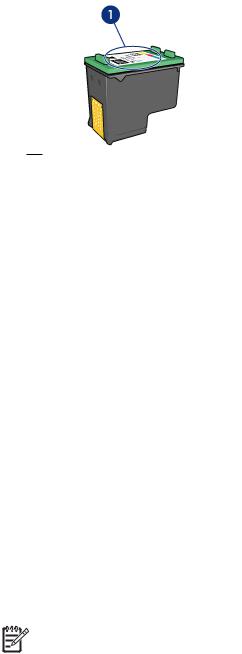
Chapter 3
You can find the selection number in three places:
●Selection number label: Look at the label on the print cartridge that you are replacing.
1Selection number label
●Printer documentation: For a list of print cartridge selection numbers, see the reference guide that came with the printer.
●Print Cartridge Ordering Information dialog box: For a list of print cartridge selection numbers, open the printer Toolbox, click the Estimated Ink Level tab, and then click the Print Cartridge Information button.
If a print cartridge runs out of ink, the printer can operate in ink-backup mode.
For information about installing a replacement print cartridge, see the print cartridge installation page.
Ink-backup mode
Use the ink-backup mode to operate the printer with only one print cartridge. The inkbackup mode is initiated when a print cartridge is removed from the print cartridge cradle.
Ink-backup mode output
Printing in ink-backup mode slows the printer and affects the quality of printouts.
Installed print |
Result |
|
cartridge |
||
|
||
|
|
|
Black print cartridge |
Colors print as grayscale. |
|
|
|
|
Tri-color print cartridge |
Colors print but black is grayed and is not a true black. |
|
|
|
|
Photo print cartridge |
Colors print as grayscale. |
|
|
|
|
Gray photo print |
Colors print as grayscale. |
|
cartridge |
||
|
||
|
|
Note HP does not recommend using the photo print cartridge or the gray photo print cartridge for ink-backup mode.
16 |
HP Deskjet 6980 series |

Exit ink-backup mode
Install two print cartridges in the printer to exit ink-backup mode.
For instructions about installing a print cartridge, see the print cartridge installation page.
Automatic paper-type sensor
The HP automatic paper-type sensor detects the paper in the printer, and then selects optimal print settings for that media. The result is fewer mouse clicks to start printing, and automatic optimal print quality on plain, photo, brochure and other high-quality papers. The sensor also checks the paper width to ensure it matches the size selected in the printer software. If the widths are different, the printer warns you so that you do not waste a sheet of paper.
When the auto paper-type sensor is engaged, the printer uses a red optical sensor light to scan the first page of a document and determine the best paper-type setting and check paper width. If the paper width is different from the printer software, the printer warns you and gives you the opportunity to stop printing. If the width matches, the printer determines the paper-type setting and the page is printed.
Note The Automatic Paper-Type Sensor is not available for documents that are printed from the 250-Sheet Plain Paper Tray Accessory or the Auto Two-Sided Print Accessory with Small Paper Tray.
For more information about using the automatic paper-type setting, see Select a paper type.
Caution Do not place the printer in direct sunlight. Direct sunlight can interfere with the auto paper-type sensor.
User's guide |
17 |
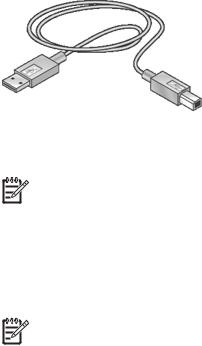
4 Connect to the printer
●Wireless networking
●Wired Ethernet networking
●Connecting a digital camera
●USB
●Bluetooth wireless printing
●HP iPAQ Wi-Fi printing
USB
The printer connects to the computer with a universal serial bus (USB) cable. The computer must be running Windows 98 SE or later to use a USB cable.
For instructions about connecting the printer with a USB cable, see the setup poster that came with the printer.
Note A USB cable might not be packaged with the printer.
Change the printer from a USB connection to a network connection
If you first install the printer with a USB connection, you can later change to either a wireless or Ethernet network connection. If you already understand how to connect to a network, you can use the general instructions that follow. For more detailed instructions on connecting the printer to a network, see the Setup Guide.
Note For optimal performance and security in a wireless network, use an access point (such as a wireless router) to connect the printer.
To change a USB connection to a wireless connection
1.Unplug the USB connection from the back of the printer.
2.Insert the printer software CD in the computer CD-ROM drive, and then follow the onscreen instructions.
This runs the Setup Wizard.
3.On the Connection Type screen, select Wireless, and then click Next.
18 |
HP Deskjet 6980 series |
4.Follow the onscreen instructions to complete the network installation.
5.When the installation is complete, open Printers and Faxes in Control Panel and delete the printers for the USB installation.
To change a USB connection to a wired (Ethernet) connection
1.Unplug the USB connection from the back of the printer.
2.Connect an Ethernet cable from the Ethernet port on the back of the printer to an available Ethernet port on the router, switch, or access point.
3.Insert the printer software CD in the computer CD-ROM drive, and then follow the onscreen instructions.
This runs the Setup Wizard.
4.On the Connection Type screen, select Wired Network, and then click Next.
5.Follow the onscreen instructions to complete the network installation.
6.When the installation is complete, open Printers and Faxes in Control Panel and delete the printers for the USB installation.
Wireless networking
For setup information, click one of the following options:
●Wireless network basics
●Wireless security
For a description of the printer's wireless feature, click one of the following options:
●SecureEasySetup button
●Wireless Status light
●Report Page button
●Network light
●Wireless radio
●HP Report page
●Embedded Web server (EWS)
Other information:
●Resetting the printer to the factory defaults
●Troubleshooting
●Glossary
Wireless networking basics
The printer's built-in wireless communications feature allows you to connect the printer directly to an 802.11g or 802.11b Wi-Fi wireless network without the aid of an external print server.
To install the printer on a wireless network, follow the wireless installation instructions in the Setup guide.
Wi-Fi
802.11g and 802.11b
Wi-Fi is a wireless communications technology that allows you to connect computers and other devices (such as printers) to each other and the Internet without the use of wires. The printer is compatible with two types of Wi-Fi technology: 802.11g and 802.11b.
User's guide |
19 |
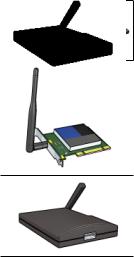
Chapter 4
Both 802.11g and 802.11b operate by radio transmission in the 2.4 Gigahertz (GHz) frequency band. 802.11g devices communicate at a maximum speed of 54 megabits per second (Mb/s). 802.11b devices communicate at a maximum speed of 11 Mb/s.
For instructions to switch the printer between 802.11b and 802.11g, click here.
802.11a
802.11a is an emerging wireless networking technology that operates in the 5 GHz frequency band and offers communication speeds similar to those of 802.11g. The printer cannot communicate with 802.11a devices over a wireless connection.
If you have an 802.11a wireless network, you can use an Ethernet cable to connect the printer to the network's Wireless Access Point (WAP) in order to achieve a processing speed comparable to that of the 802.11a network. If your wireless network supports 802.11g and 802.11b technology, another option is to switch the rest of the network to the lower frequency to use the printer wirelessly.
To connect the printer to an Ethernet network, follow the Ethernet network installation instructions.
Adapters and access points Adapters
While some devices, such as the printer, have built-in Wi-Fi capability, other devices need an adapter to become Wi-Fi-enabled.
Examples of common adapters include:
PCMCIA card that plugs into the PCMCIA slot in a laptop
ISA or PCI card that can be used with a desktop computer
USB adapter that connects to the USB port on a desktop or laptop computer
Other types of adapters are available. All adapters come with configuration software that allows you to configure the adapter for a wireless network.
Access points
Infrastructure networks are a common variety of wireless network. An infrastructure network requires the use of a Wireless Access Point (WAP).
20 |
HP Deskjet 6980 series |
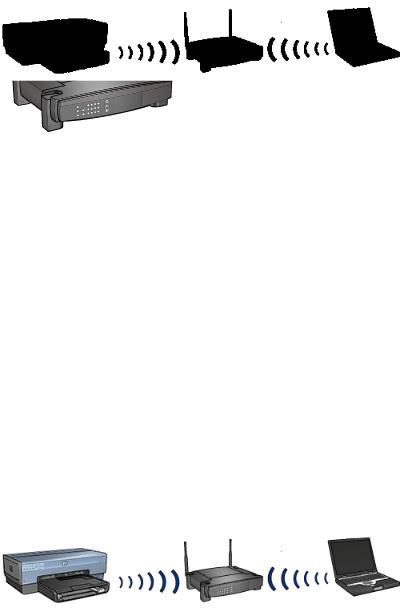
A WAP acts as a central hub for a wireless network or as a router connecting the wireless network to another network (such as the Internet or an Ethernet network). Devices on the network communicate through the WAP.
Wireless network examples
To see some examples of wireless networks, see the wireless network examples page.
Communication modes
There are two types of communication modes for wireless devices:
●Infrastructure mode
●ad hoc
Infrastructure mode
For optimal performance and security in a wireless network, HP recommends you use a Wireless Access Point (WAP) (802.11b or g) to connect the printer and other network devices. When network devices are connected through an access point, this is called an infrastructure network. A wireless network without an access point is called an ad hoc network.
The advantages of a wireless infrastructure network as compared to an ad hoc network include:
●Advanced network security
●Enhanced reliability
●Network flexibility
●Better performance, especially with 802.11g mode
●Shared Internet access
What you need for a wireless infrastructure network
User's guide |
21 |
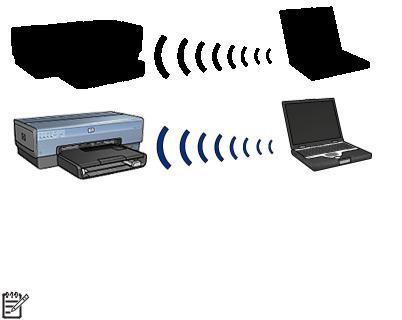
Chapter 4
To connect the printer to a wireless network, you need the following:
●A wireless 802.11b or g network that includes a wireless access point.
●A desktop computer or laptop with either wireless networking support, or a network interface card (NIC). You can use either an Ethernet (wired) connection or a wireless connection from the computer to the access point. If you want to use an Ethernet connection to the access point, follow the directions in the Setup Guide.
●Broadband Internet access (recommended) such as cable or DSL. If you connect the printer on a wireless network that has Internet access, HP recommends that you use a wireless router (access point) that uses Dynamic Host Configuration Protocol (DHCP).
●Network name (SSID)
●WEP key (suggested), WPA Passphrase (if needed)
Ad hoc mode
When the printer is set to the ad hoc communication mode, the printer communicates directly with other wireless devices on the network without the use of a WAP. You might want to use an ad hoc connection if you do not want to invest in an access point, or you want to set up a simpler, more casual network.
Note An ad hoc is available if you do not have an access point. However, it provides little flexibility, a low level of network security, and slower network performance than with an access point.
For a wireless ad hoc setup, you need to manually turn on the wireless radio.
Switch between 802.11b and 802.11g
The ad hoc communication mode defaults to 802.11b. The infrastructure communication mode defaults to 802.11g. Use the printer's embedded Web server (EWS) to change these settings.
Note To switch from ad hoc 802.11b to ad hoc 802.11g, the computer must have an 802.11g card or adapter installed.
Wireless network settings
Devices (such as computers and printers) on a wireless network must share the following settings:
Network name (SSID)
22 |
HP Deskjet 6980 series |
A network name, or "Service Set Identifier (SSID)," identifies a particular wireless network. In order to operate on a network, a device must know the network's network name.
For an in-depth explanation of network names, see the network names page.
Wireless profiles
A wireless profile is a group of network settings unique to a given wireless network. A wireless device might have wireless profiles for several wireless networks. In order to use the printer, the computer must be set to the profile for the printer's wireless network.
For example, a laptop that is used both at work and at home, might have one profile for a wireless network at work and another profile for a wireless network at home.
The printer does not support multiple profiles.
For more information on wireless profiles, see the wireless profiles page.
Wireless security
Devices on a wireless network must share the same security settings.
For a description of the wireless security options available for the printer, see the wireless security page.
Reduce interference in a wireless network
The following tips help reduce the chances for interference in a wireless network:
●Keep the wireless devices away from large metal objects, such as filing cabinets, and other electromagnetic devices, such as microwaves and cordless telephones, as these objects can disrupt radio signals.
●Keep the wireless devices away from large masonry structures and other building structures as these objects can absorb radio waves and lower signal strength.
●For an infrastructure network, position the WAP in a central location in line of sight with the wireless devices on the network.
●Keep all wireless devices on the network within range of one another.
Printing
Computers on the network send print jobs directly to the printer, which prints them in the order received.
The printer can accept print jobs sent simultaneously from four users.
For example, if five users each send a print job to the printer at the same time, the printer accepts four of the print jobs and rejects the fifth. The user who sent the fifth print job should wait a few minutes and then resend the print job.
Wireless network examples
There are three common configurations for wireless networks:
Ad hoc networks
An ad hoc network is a type of wireless network in which devices directly communicate with each other rather than through a Wireless Access Point (WAP).
User's guide |
23 |
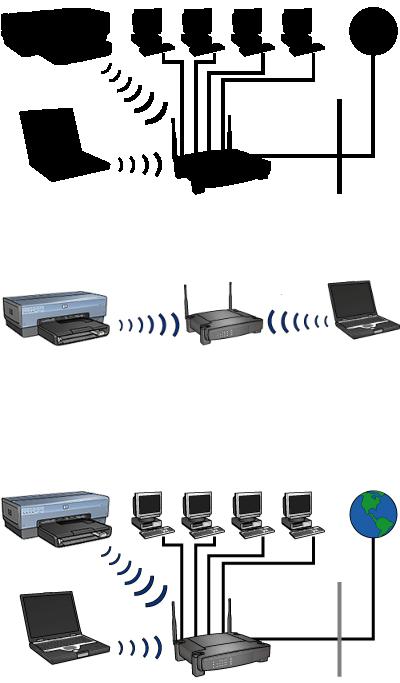
Chapter 4
For example, a simple ad hoc wireless network might consist of a laptop and a printer communicating directly with one another.
Ad hoc networks are typically small and simple. Performance on these types of networks can degrade if more than six devices are on the network.
Infrastructure networks
On an infrastructure network, devices, such as computers and printers, communicate through a Wireless Access Point (WAP). WAPs act as routers or gateways on small networks.
For example, a simple infrastructure wireless network might consist of a laptop and a printer communicating through a WAP.
Mixed wired and wireless networks
Wireless devices often exist on a largely wired network.
In this case, a WAP is connected to the main network by an Ethernet cable plugged into the WAP's WAN port. The WAP acts as the go-between for the wired devices and the wireless devices. The wired devices communicate with the WAP over the Ethernet cable, while the wireless devices communicate with the WAP over radio waves.
24 |
HP Deskjet 6980 series |

For example, a mixed wired and wireless network can consist of the following:
●Several desktop computers
●A WAP connected to an Ethernet network
●A printer connected wirelessly to the WAP
In order to use the printer, a desktop PC sends a print job over the Ethernet cable to the WAP. The WAP then wirelessly transmits the print job to the printer.
Wireless profiles
A wireless profile is a set of network settings unique to a given wireless network.
Many wireless devices have configuration utilities that allows the device to have wireless profiles for several wireless networks. In order to use the printer, the computer must be set to the profile for the printer's wireless network.
Note Not all wireless devices support multiple profiles.
The printer only supports one wireless profile.
Example
A person uses the same wireless-enabled laptop at work and at home. They have one wireless network at work, and another wireless network at home
Each network has a unique set of wireless settings. The person creates the following wireless profiles on the laptop:
●at_work: Contains the network settings for the office wireless network
●at_home: Contains the network settings for the home wireless network
Wireless network |
Profile |
|
location |
|
|
|
|
|
Office |
at_work |
|
|
● |
Network name: office |
|
● |
Communication mode: infrastructure |
|
● |
Security: WPA |
|
● |
Authentication: WPA/PSK |
Home |
at_home |
|
|
● |
Network name: home |
|
● Communication mode: ad hoc |
|
|
● |
Security: WEP |
|
● |
Authentication: Open System |
User's guide |
25 |

Chapter 4
When the laptop is being used at work, the person must set the wireless profile to at_work in order to connect to the office network.
Conversely, the laptop must be set to the at_home wireless profile when the person is at home and wants to connect the laptop to the home network.
Network name (SSID)
A network name, or "Service Set Identifier (SSID)," identifies a particular wireless network. In order to operate on a network, a device must know the network's name.
A wireless network only has one network name.
A given location, such as an office, might have several wireless networks, each with a different network name. Wireless devices use network names to identify overlapping wireless networks.
Caution To prevent other users from accessing the wireless network, HP strongly recommends setting a password or passphrase and a unique SSID in your access point. The access point might have been shipped with a default SSID which can be accessed by others using the same default SSID. For more information on how to change the SSID, see the documentation that came with your access point.
Example
The printer is in an office with two wireless infrastructure networks. Each network has a Wireless Access Point (WAP).
Note In this example, both wireless networks have the same security settings.
1 |
Network name equals "network_1" |
2 |
Network name equals "network_2" |
The network name for one wireless network is network_1. The network name for the other wireless network is network_2.
The printer is configured for network_1
The printer's network name (SSID) setting has been configured for network_1. The printer can only communicate to network_1. In other words, the printer can only accept print jobs from network_1.
26 |
HP Deskjet 6980 series |
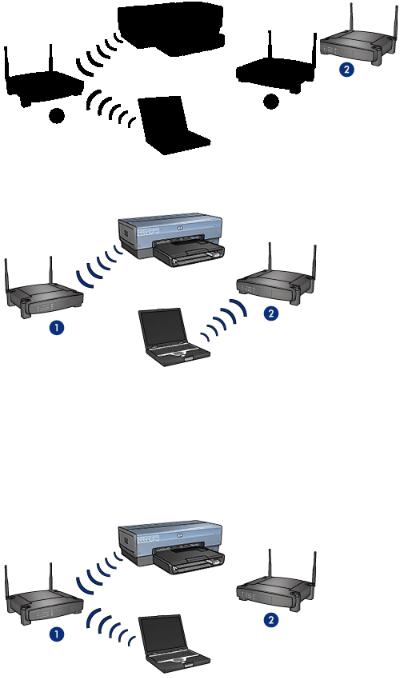
1 |
Network name equals "network_1" |
2 |
Network name equals "network_2" |
The laptop is configured for network_2
The laptop's network name (SSID) settings have been configured for network_2. The laptop is unable to communicate with the printer and cannot send print jobs to the printer.
1 |
Network name equals "network_1" |
2 |
Network name equals "network_2" |
The laptop is reconfigured for network_1
The laptop's network name (SSID) settings have been reconfigured for network_1. The laptop is able to communicate with the printer and is ready to send print jobs to network_1.
1 |
Network name equals "network_1" |
2 |
Network name equals "network_2" |
User's guide |
27 |

Chapter 4
Wireless security
The printer can be configured for several wireless security options depending on the type of wireless network of which the printer is part.
Infrastructure networks
●WPA
●WEP
●Open System
Ad hoc networks (wireless direct-connect)
●WEP
●Open System
For more information about wireless security, see the authentication and encryption page.
Add security to the network
As with other networks, security for wireless local area networks (WLANs) focuses on access control and privacy. Traditional WLAN security includes the use of Service Set Identifiers (SSIDs), open or shared-key authentication, static Wired Equivalent Privacy (WEP) keys, and optional Media Access Control (MAC) authentication. This combination offers a rudimentary level of access control and privacy.
If you are using an access point, you might also employ advanced forms of authentication and encryption on the WLAN, such as the Pre-Shared Key mode of Wi-Fi Protected Access (WPA-PSK).
To protect the wireless network, HP strongly suggests you implement a wireless security scheme (either WEP or WPA) during setup, use an antivirus program to protect against computer viruses, and follow basic security rules such as setting strong passwords and not opening unknown attachments. Other network components, including firewalls, intrusion-detection systems, and segmented networks, should also be considered as part of the network design.
Note If you decide to add encryption and authentication to the network after installing the printer, change the settings on the printer prior to changing them on other devices on the network.
Authentication and encryption
Wireless security is a complex and developing topic. This page gives a brief overview of the basics involved in making a wireless network secure.
In the simplest terms, wireless security involves two strategies: authentication and encryption.
A wireless security method, such as WEP or WPA, involves varying levels of authentication and encryption.
Authentication Definition
Authentication verifies the identity of a user or device before granting access to a network, making it more difficult for unauthorized users to access network resources.
28 |
HP Deskjet 6980 series |
